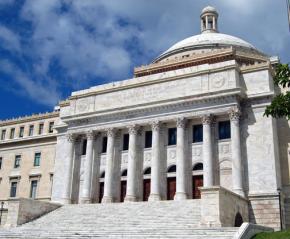Debt stalks Puerto Rico
, an economist and member of the Committee to Abolish Third World Debt's Latin America Caribbean network, looks at how austerity is shaping Puerto Rico.
WHEN WE mention the debt crisis, the first images that come to mind are the marches and protests in the streets of Madrid or Athens. But the negative impact of the debt system on the lives of the people is felt all over the world.
Not even the sunny and placid lands of the Caribbean are immune to the destabilizing power of that system. In this case, the victim is the island of Puerto Rico, where the uncontrolled increase of the debt has placed it on the edge of bankruptcy.
The history of how the island has reached this point is relatively simple. Given its status as a territory occupied by the United States, Puerto Rico has access to a series of fiscal benefits and exemptions which are very attractive to U.S. investors. Although it is not a state of the union, bonds issued by the government of Puerto Rico have the same legal standing as U.S. state and municipal bonds. In order to facilitate access to funds at preferential rates, interest payments on these bonds is tax-exempt. In that sense, the key difference between Puerto Rico and the states of the union is the interest rates that they pay. Thus, while a state with fiscal problems such as California issues debt at 2.37 percent interest, Puerto Rico does so at 8 or 10 percent.[1]

In a context characterized by low interest rates on a global level, this yield is very attractive to investors. There are two further benefits. First, according to the laws of Puerto Rico, interest payments must be considered a priority over any other government expenditure. Secondly, there was an implicit understanding that the government of Puerto Rico could count on the support of the U.S. federal government. Given these features, financial markets came to see the island as good and secure opportunity to increase their profits.
From the perspective of Puerto Rico, the availability of external funds made it possible to temporarily mask the fiscal problems, thus postponing difficult decisions. Between 2007 and 2012, the economy contracted year after year. The shrinking of the economy reduced government earnings and accentuated the need for external financing. At its worst moment, in 2009, the state budget deficit reached 6 percent of the GDP. This risky balance lasted until 2013.
In July of 2013, the declaration of bankruptcy by the city of Detroit changed everything. Investors' trust on state and municipal bonds vanished. When markets began to shed Puerto Rico's bonds, the island's debt had already reached $70 billion (102 percent of GNP). Given the incapacity of issuing new bonds since July 2013, Puerto Rico has been forced to seek short-term financing from banks that charge higher interest rates, given the possibility of a default. This has only increased the doubts regarding the government's capacity to come out of the crisis without a default and an eventual restructuring of its debt.
GIVEN THIS difficult situation, the government of Puerto Rico has presented a series of austerity measures as an original and innovative way to deal with the crisis. As may be expected, austerity in its Caribbean version does not differ much from its European version.
Placing the payment of the debt above all else, the government has frozen state pensions, increased taxes and tariffs for public services. Given the negative impact on future economic perspectives, financial markets retain a skeptical attitude regarding Puerto Rico's fiscal health. This has increased the rumors regarding the need of a federal rescue of the island territory, coordinated by the U.S. Congress.
While the investors wait, Puerto Ricans suffer the consequences of the austerity measures. The unemployment rate is now 15 percent and an estimated 45 percent of the population lives under the poverty level. Around 50 percent of the population receives some sort of federal government aid. It is estimated that during the last five years 65,000 persons have emigrated each year in search of better opportunities in the continent. The population that stays behind includes older people and those with least qualifications, a fact which further darkens future prospects for the island.
To conclude, it should be pointed out that the country can hardly find a solution to its problems within the logic of financial markets. In the specific case of Puerto Rico, the relation between sovereignty and debt obligations must be taken into account. It is possible to argue that given Puerto Rico's condition as an occupied territory the debt has an illegitimate character. Thus, the people of Puerto Rico have no obligation to pay it.
Ironically, the United States established this legal principle in another Caribbean island in 1898. After the Spanish American War, the United States argued that due to its colonial status, Cuba was not bound to pay its debt to Spain. It would be a lovely turn of fate for the oppressed to now wield this argument against their oppressors in order to cancel their debt.
In that sense, the struggle for a free and independent Puerto Rico, both from the debt and from the U.S. occupation, is one and the same struggle for justice.
Notes
1. The rates of interest mentiones correspond to 2013. For California interest rates see http://www.bloomberg.com/news/2013-04-11/california-sells-38-of-2-billion-issue-to-individuals.html. For Puerto Rico interest rates see http://www.economist.com/news/finance-and-economics/21588364-heavily-indebted-island-weighs-americas-municipal-bond-market-puerto-pobre.
Translation by Rafael Barnabe. First published at the Committee for Abolition of Third World Debt.


